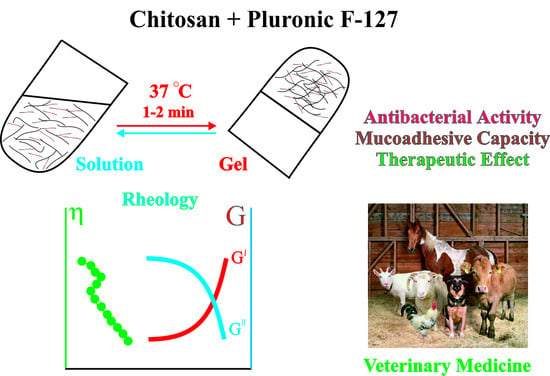Thermosensitive Chitosan-Containing Hydrogels: Their Formation, Properties, Antibacterial Activity, and Veterinary Usage
Abstract
:1. Introduction
2. Results and Discussion
2.1. Rheological Tests
2.2. Mucoadhesive Properties
2.3. Effect of D-AscA on Rheological and Mucoadhesive Properties
2.4. Scanning Electron Microscopy (SEM)
2.5. Antibacterial Activity In Vitro
2.6. Therapeutic Effect In Vivo
3. Conclusions
4. Materials and Methods
4.1. Materials
4.2. Solution Preparation
4.3. Rheological Tests
4.4. Adhesive Properties
4.5. Scanning Electron Microscopy
4.6. Antibacterial Activity
4.7. Treatment and Prevention of Vaginitis in Cows
5. Patents
Author Contributions
Funding
Institutional Review Board Statement
Informed Consent Statement
Data Availability Statement
Conflicts of Interest
References
- Mahinroosta, M.; Farsangi, Z.J.; Allahverdi, A.; Shakoori, Z. Hydrogels as intelligent materials: A brief review of synthesis, properties and applications. Mater. Today Chem. 2018, 8, 42–55. [Google Scholar] [CrossRef]
- Moon, H.J.; Ko, D.Y.; Park, M.H.; Joo, M.K.; Jeong, B. Temperature-responsive compounds as in situ gelling biomedical materials. Chem. Soc. Rev. 2012, 41, 4860–4883. [Google Scholar] [CrossRef] [PubMed]
- Li, Y.; Yang, H.Y.; Lee, D.S. Advances in biodegradable and injectable hydrogels for biomedical applications. J. Control. Release 2021, 330, 151–160. [Google Scholar] [CrossRef] [PubMed]
- Pagano, C.; Giovagnoli, S.; Perioli, L.; Tiralti, M.C.; Ricci, M. Development and characterization of mucoadhesive-thermoresponsive gels for the treatment of oral mucosa diseases. Eur. J. Pharm. Sci. 2020, 142, 105125. [Google Scholar] [CrossRef] [PubMed]
- Younes, I.; Rinaudo, M. Chitin and chitosan preparation from marine sources. Structure, properties and applications. Marine Drugs 2015, 13, 1133–1174. [Google Scholar] [CrossRef] [PubMed] [Green Version]
- Sogias, I.A.; Williams, A.C.; Khutoryanskiy, V.V. Chitosan-based mucoadhesive tablets for oral delivery of ibuprofen. Int. J. Pharm. 2012, 436, 602–610. [Google Scholar] [CrossRef]
- Deshmane, S.V.; Channawar, M.A.; Chandewar, A.V.; Joshi, U.M.; Biyani, K.R. Chitosan based sustained release mucoadhesive buccal patches containing verapamil HCL. Int. J. Pharm. Pharm. Sci. 2009, 1, 216–229. [Google Scholar]
- Ivarsson, D.; Wahlgren, M. Comparison of in vitro methods of measuring mucoadhesion: Ellipsometry, tensile strength and rheological measurements. Colloids Surf. B 2012, 92, 353–359. [Google Scholar] [CrossRef]
- Rahmanian-Devin, P.; Baradaran Rahimi, V.; Askari, V.R. Thermosensitive chitosan-β-glycerophosphate hydrogels as targeted drug delivery systems: An overview on preparation and their applications. Adv. Pharm. Pharm. Sci. 2021, 2021, 17. [Google Scholar] [CrossRef]
- Shi, L.; Yang, L.; Chen, J.; Pei, Y.; Chen, M.; Hui, B.; Li, J. Preparation and characterization of pH-sensitive hydrogel of chitosan/poly (acrylic acid) co-polymer. J. Biomater. Sci. Polym. Ed. 2004, 15, 465–474. [Google Scholar] [CrossRef]
- Irimia, T.; Dinu-Pîrvu, C.E.; Ghica, M.V.; Lupuleasa, D.; Muntean, D.L.; Udeanu, D.I.; Popa, L. Chitosan-based in situ gels for ocular delivery of therapeutics: A state-of-the-art review. Mar. Drugs 2018, 16, 373. [Google Scholar] [CrossRef] [PubMed] [Green Version]
- Ren, Y.; Zhang, D.; He, Y.; Chang, R.; Guo, S.; Ma, S.; Yao, M.; Guan, F. Injectable and antioxidative HT/QGA hydrogel for potential application in wound healing. Gels 2021, 7, 204. [Google Scholar] [CrossRef] [PubMed]
- Luo, Y.; Mills, D.K. The effect of halloysite addition on the material properties of chitosan–halloysite hydrogel composites. Gels 2019, 5, 40. [Google Scholar] [CrossRef] [PubMed] [Green Version]
- Gupta, H.; Velpandian, T.; Jain, S. Ion-and pH-activated novel in-situ gel system for sustained ocular drug delivery. J. Drug Target. 2010, 18, 499–505. [Google Scholar] [CrossRef]
- Yang, Y.; Wang, S.; Wang, Y.; Wang, X.; Wang, Q.; Chen, M. Advances in self-assembled chitosan nanomaterials for drug delivery. Biotechnol. Adv. 2014, 32, 1301–1316. [Google Scholar] [CrossRef]
- Domínguez-Delgado, C.L.; Fuentes-Prado, E.; Escobar-Chávez, J.J.; Vidal-Romero, G.; Rodríguez-Crus, I.M.; Díaz-Torres, R. Encyclopedia of Biomedical Polymers and Polymeric Biomaterials; Taylor and Francis: New York, NY, USA, 2016; pp. 1513–1535. [Google Scholar]
- Strandman, S.; Zhu, X.X. Self-healing supramolecular hydrogels based on reversible physical interactions. Gels 2016, 2, 16. [Google Scholar] [CrossRef] [Green Version]
- Wanka, G.; Hoffmann, H.; Ulbricht, W. Phase diagrams and aggregation behavior of poly (oxyethylene)-poly (oxypropylene)-poly (oxyethylene) triblock copolymers in aqueous solutions. J. Macromol. 1994, 27, 4145–4159. [Google Scholar] [CrossRef]
- Abou-Shamat, M.A.; Calvo-Castro, J.; Stair, J.L.; Cook, M.T. Modifying the properties of thermogelling poloxamer 407 solutions through covalent modification and the use of polymer additives. Macromol. Chem. Phys. 2019, 220, 1–19. [Google Scholar] [CrossRef]
- Singh, N.K.; Lee, D.S. In situ gelling pH- and temperature-sensitive biodegradable block copolymer hydrogels for drug delivery. J. Control. Release 2014, 193, 214–227. [Google Scholar] [CrossRef]
- Gratieri, T.; Gelfuso, G.M.; Rocha, E.M.; Sarmento, V.H.; de Freitas, O.; Lopez, R.F. A poloxamer/chitosan in situ forming gel with prolonged retention time for ocular delivery. Eur. J. Pharm. Biopharm. 2010, 75, 186–193. [Google Scholar] [CrossRef]
- Dumortier, G.; Grossiord, J.L.; Agnely, F.; Chaumeil, J.C. A review of poloxamer 407 pharmaceutical and pharmacological characteristics. Pharm. Res. 2006, 23, 2709–2728. [Google Scholar] [CrossRef] [PubMed]
- Rossi, S.; Ferrari, F.; Bonferoni, M.C.; Faccendini, A.; Puccio, A.; Caramella, C. Comparison of poloxamer- and chitosan-based thermally sensitive gels for the treatment of vaginal mucositis. Drug. Dev. Ind. Pharm. 2014, 40, 352–360. [Google Scholar] [CrossRef] [PubMed]
- Turabee, M.H.; Jeong, T.H.; Ramalingam, P.; Kang, J.H.; Ko, Y.T. N,N,N-trimethyl chitosan embedded in situ Pluronic F127 hydrogel for the treatment of brain tumor. Carbohydr. Polym. 2019, 203, 302–309. [Google Scholar] [CrossRef] [PubMed]
- Budkina, O.A.; Demina, T.V.; Dorodnykh, T.Y.; Melik-Nubarov, N.S.; Grozdova, I.D. Cytotoxicity of nonionic amphiphilic copolymers. Polym. Sci. Ser. A 2012, 54, 707–717. [Google Scholar] [CrossRef]
- Kang, M.L.; Jiang, H.L.; Kang, S.G.; Guo, D.D.; Lee, D.Y.; Cho, C.S.; Yoo, H.S. Pluronic® F127 enhances the effect as an adjuvant of chitosan microspheres in the intranasal delivery of Bordetella bronchiseptica antigens containing dermonecrotoxin. Vaccine 2007, 25, 4602–4610. [Google Scholar] [CrossRef] [PubMed]
- Park, M.H.; Joo, M.K.; Choi, B.G.; Jeong, B. Biodegradable thermogels. Acc. Chem. Res. 2012, 45, 424–433. [Google Scholar] [CrossRef]
- Vlahos, A.; Yu, P.; Lucas, C.E.; Ledgerwood, A.M. Effect of a composite membrane of chitosan and poloxamer gel on postoperative adhesive interactions. Am. Surg. 2001, 67, 15–21. [Google Scholar]
- Moghimi, S.M.; Hunter, A.C. Poloxamers and poloxamines in nanoparticle engineering and experimental medicine. Trends Biotechnol. 2000, 18, 412–420. [Google Scholar] [CrossRef]
- Valle, J.W.; Armstrong, A.; Newman, C.; Alakhov, V.; Pietrzynski, G.; Brewer, J.; Campbell, S.; Corrie, P.; Rowinsky, E.K.; Ranson, M. A phase 2 study of SP1049C, doxorubicin in P-glycoprotein-targeting Pluronics, in patients with advanced adenocarcinoma of the esophagus and gastroesophageal junction. Investig. New Drugs 2011, 29, 1029–1037. [Google Scholar] [CrossRef]
- El-Dahmy, R.M.; Elshafeey, A.H.; Abd El Gawad, N.A.; El-Gazayerly, O.N.; Elsayed, I. Statistical optimization of nanostructured gels for enhancement of vinpocetine transnasal and transdermal permeation. J. Drug Deliv. Sci. Technol. 2021, 66, 102871. [Google Scholar] [CrossRef]
- Jayaramudu, T.; Varaprasad, K.; Reddy, K.K.; Pyarasani, R.D.; Akbari-Fakhrabadi, A.; Amalraj, J. Chitosan-pluronic based Cu nanocomposite hydrogels for prototype antimicrobial applications. Int. J. Biol. Macromol. 2020, 143, 825–832. [Google Scholar] [CrossRef]
- Modi, D.; Mohammad; Warsi, M.H.; Garg, V.; Bhatia, M.; Kesharwani, P.; Jain, G.K. Formulation development, optimization, and in vitro assessment of thermoresponsive ophthalmic pluronic F127-chitosan in situ tacrolimus gel. J. Biomater. Sci. Polym. Ed. 2021, 32, 1678–1702. [Google Scholar] [CrossRef] [PubMed]
- Malinkina, O.N.; Gegel, N.O.; Shipovskaya, A.B. Hydrodynamic behavior of chitosan hydrochloride macromolecules in aqueous solutions of D- and L-ascorbic acid. J. Mol. Liq. 2019, 284, 75–81. [Google Scholar] [CrossRef]
- Gegel, N.O.; Zhuravleva, Y.Y.; Shipovskaya, A.B.; Malinkina, O.N.; Zudina, I.V. Influence of chitosan ascorbate chirality on the gelation kinetics and properties of silicon-chitosan-containing glycerohydrogels. Polymers 2018, 10, 259. [Google Scholar] [CrossRef] [Green Version]
- Gegel, N.O.; Zudina, I.V.; Malinkina, O.N.; Shipovskaya, A.B. Effect of ascorbic acid isomeric forms on antibacterial activity of its chitosan salts. Microbiology 2018, 8, 732–737. [Google Scholar] [CrossRef]
- Shipovskaya, A.B.; Malinkina, O.N.; Gegel, N.O.; Zudina, I.V.; Lugovitskaya, T.N. Structure and properties of chitosan salt complexes with ascorbic acid diastereomers. Russ. Chem. Bull. 2021, 70, 1765–1774. [Google Scholar] [CrossRef]
- Malinkina, O.N.; Zhuravleva, Y.Y.; Shipovskaya, A.B. Wound-healing activity in vivo of the glycerohydrogel plates based on ascorbate chitosan, aloe vera and silicon polyolate. Appl. Biochem. Microbiol. 2022, 58. in press. [Google Scholar] [CrossRef]
- Kardumyan, V.V.; Aksenova, N.A.; Glagolev, N.N.; Timashev, P.S.; Solovieva, A.B. Influence of acetic acid on the photocatalytic activity of photosensitiser–amphiphilic polymer complexes in the oxidation reaction of tryptophan. J. Chem. Phys. 2020, 152, 194901. [Google Scholar] [CrossRef]
- Prud’homme, R.K.; Wu, G.; Schneider, D.K. Structure and rheology studies of poly (oxyethylene−oxypropylene−oxyethylene) aqueous solution. Langmuir 1996, 12, 4651–4659. [Google Scholar] [CrossRef]
- Bansil, R.; Turner, B.S. The biology of mucus: Composition, synthesis and organization. Adv. Drug Deliv. Rev. 2018, 124, 3–15. [Google Scholar] [CrossRef]
- Kharlamov, V.N.; Gegel, N.O.; Shipovskaya, A.B.; Khaptsev, Z.Y.; Rodionov, R.V. Means for the Prevention and Treatment of Vaginitis in Cows. Patent RF 2751876, 19 July 2021. [Google Scholar]
- Shipovskaya, A.B.; Abramov, A.Y.; Pyshnograi, G.V.; Aziz, A.J.H.N. Rheological properties of aqueous acid solutions of chitosan: Experiment and calculations of the viscometric functions on the basis of a mesoscopic model. J. Eng. Phys. Thermophys. 2016, 89, 642–651. [Google Scholar] [CrossRef]
- Carvalho, F.C.; Bruschi, M.L.; Evangelista, R.C.; Gremião, M.P.D. Mucoadhesive drug delivery systems. Braz. J. Pharm. Sci. 2010, 46, 1–17. [Google Scholar] [CrossRef] [Green Version]
- Khutoryanskiy, V.V. Advances in mucoadhesion and mucoadhesive polymers. Macromol. Biosci. 2011, 11, 748–764. [Google Scholar] [CrossRef] [PubMed]
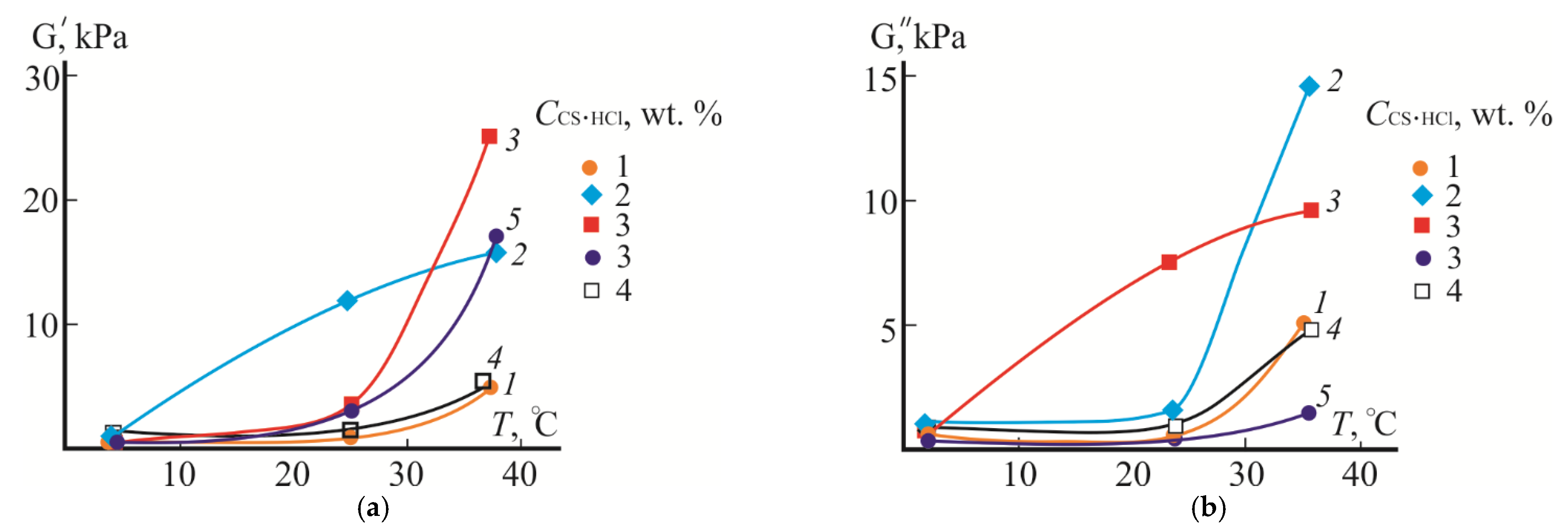

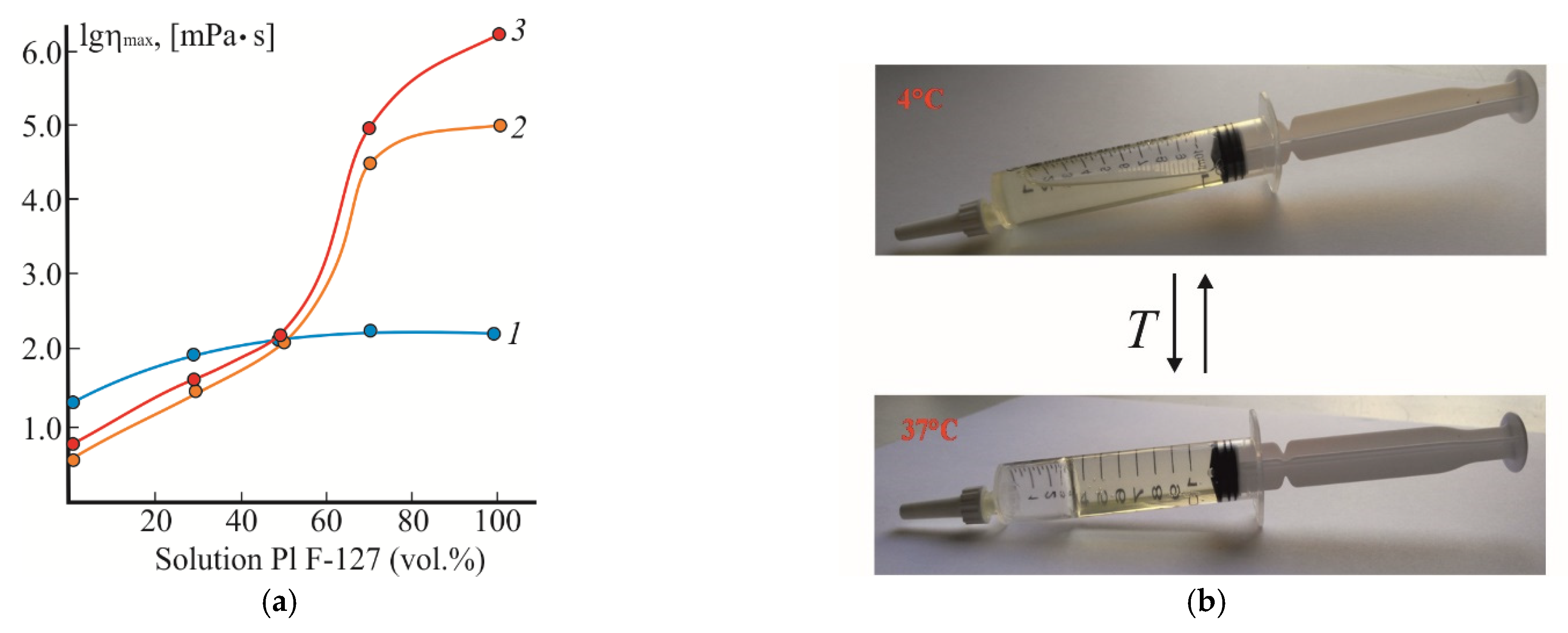
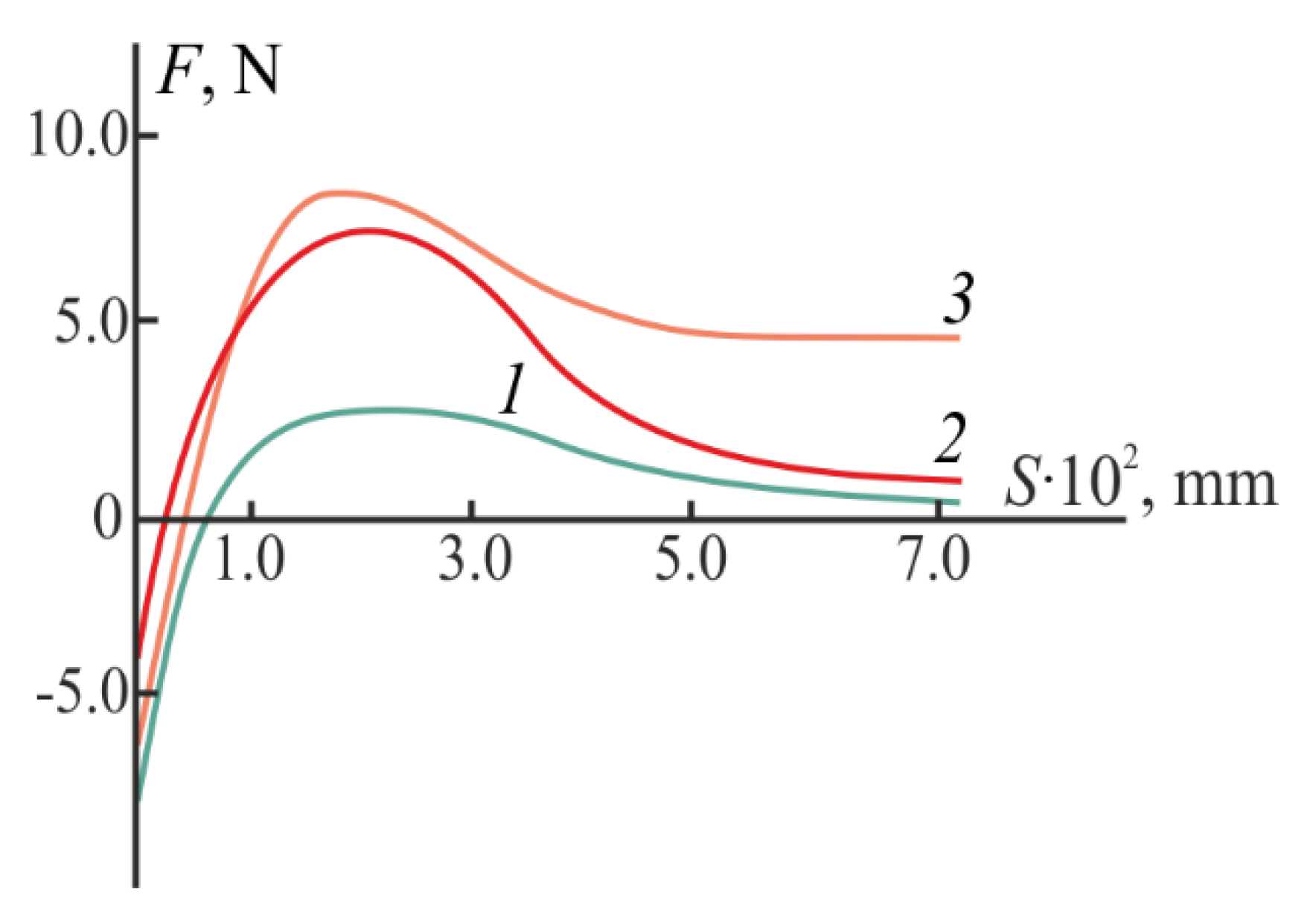
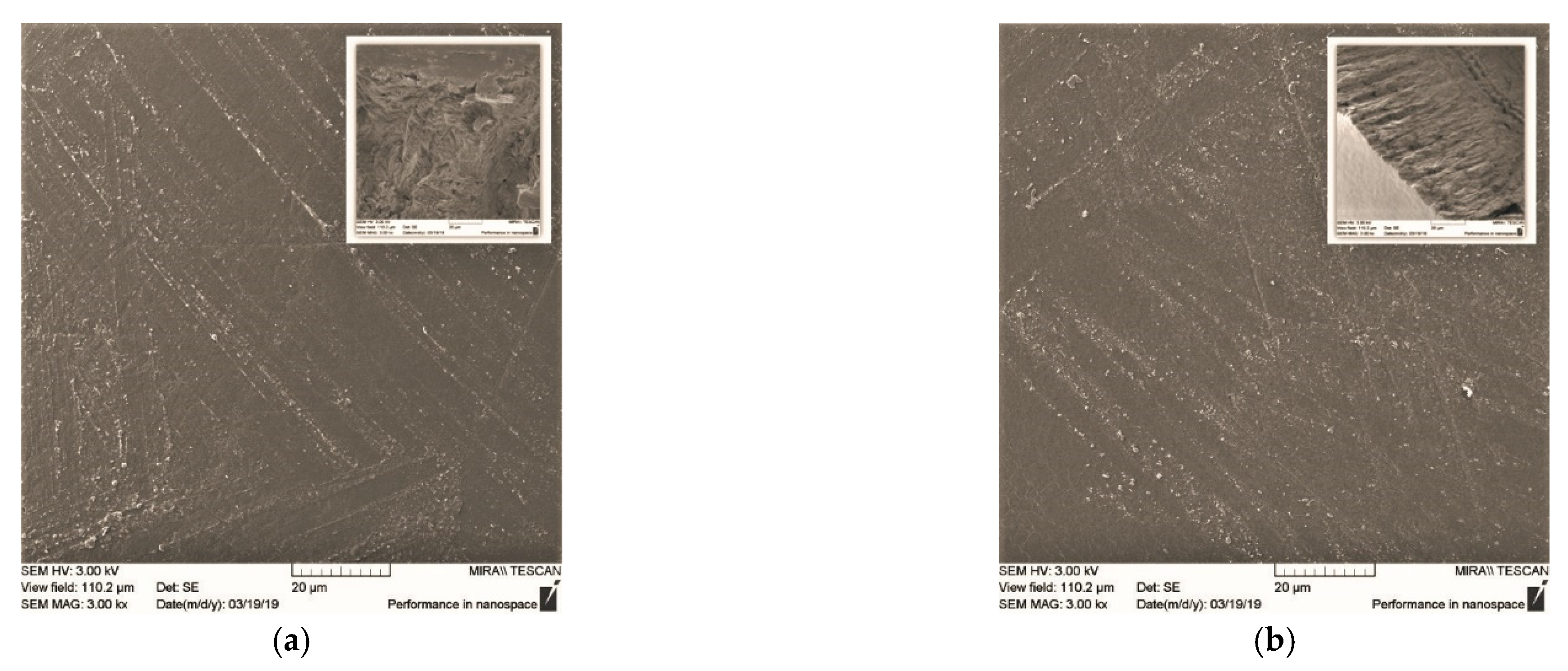

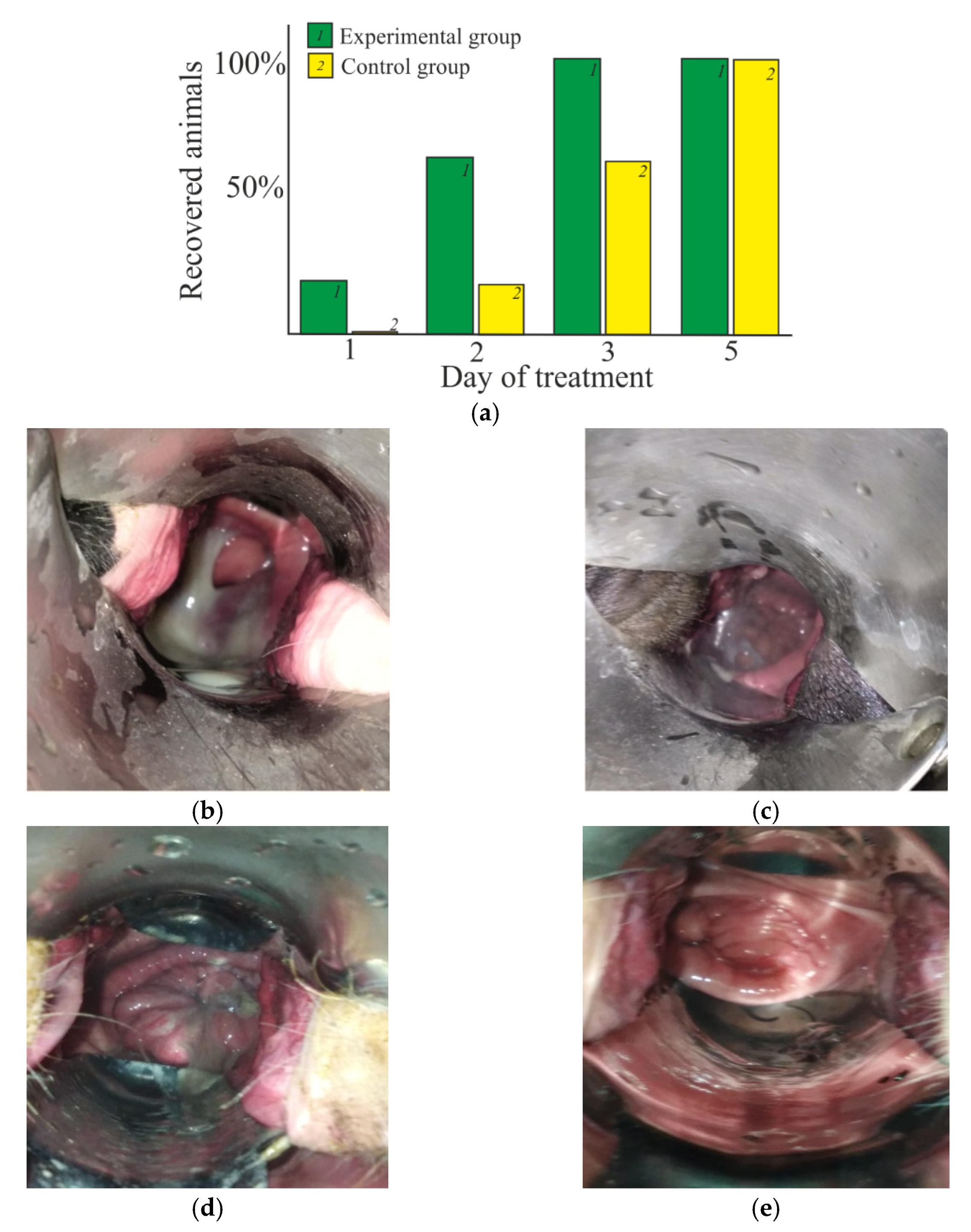
| Sample | Maximum Pull-Off Force, Fmax, N/m2 | Work of Adhesion, W∙103, J |
|---|---|---|
| CS·HCl:Pl F-127 | 1530 | 66.6 |
| CS·HCl:Pl F-127 + D-AscA | 4135 | 145.1 |
| Metrogyl Denta™ | 4440 | 174.3 |
| Bacterial Test Culture | Bacteriostatic Action | Bacterial Growth Inhibition Zone Diameter, mm | ||||||
|---|---|---|---|---|---|---|---|---|
| CS·HCl:Pl F-127 | CS·HCl + D-AscA | D-AscA | CS·HCl:Pl F-127 | CS·HCl + D-AscA | D-AscA | |||
| − | D-AscA | − | D-AscA | |||||
| P. aeruginosa (−) | ++ | ++ | ++ | + | 25 ± 1 | 23 ± 2 | 27 ± 2 | 13 ± 1 |
| S. typhimurium (−) | ++ | + | N/A | N/A | 20 ± 2 | 15 ± 2 | N/A | N/A |
| B. cereus (+) | ++ | + | N/A | N/A | 21 ± 1 | 16 ± 1 | N/A | N/A |
| S. aureus (+) | ++ | ++ | ++ | + | 26 ± 2 | 24 ± 1 | 24 ± 2 | 14 ± 2 |
Publisher’s Note: MDPI stays neutral with regard to jurisdictional claims in published maps and institutional affiliations. |
© 2022 by the authors. Licensee MDPI, Basel, Switzerland. This article is an open access article distributed under the terms and conditions of the Creative Commons Attribution (CC BY) license (https://creativecommons.org/licenses/by/4.0/).
Share and Cite
Gegel, N.O.; Shipovskaya, A.B.; Khaptsev, Z.Y.; Radionov, R.V.; Belyaeva, A.A.; Kharlamov, V.N. Thermosensitive Chitosan-Containing Hydrogels: Their Formation, Properties, Antibacterial Activity, and Veterinary Usage. Gels 2022, 8, 93. https://doi.org/10.3390/gels8020093
Gegel NO, Shipovskaya AB, Khaptsev ZY, Radionov RV, Belyaeva AA, Kharlamov VN. Thermosensitive Chitosan-Containing Hydrogels: Their Formation, Properties, Antibacterial Activity, and Veterinary Usage. Gels. 2022; 8(2):93. https://doi.org/10.3390/gels8020093
Chicago/Turabian StyleGegel, Natalia O., Anna B. Shipovskaya, Zaur Yu. Khaptsev, Roman V. Radionov, Anastasia A. Belyaeva, and Vitaly N. Kharlamov. 2022. "Thermosensitive Chitosan-Containing Hydrogels: Their Formation, Properties, Antibacterial Activity, and Veterinary Usage" Gels 8, no. 2: 93. https://doi.org/10.3390/gels8020093
APA StyleGegel, N. O., Shipovskaya, A. B., Khaptsev, Z. Y., Radionov, R. V., Belyaeva, A. A., & Kharlamov, V. N. (2022). Thermosensitive Chitosan-Containing Hydrogels: Their Formation, Properties, Antibacterial Activity, and Veterinary Usage. Gels, 8(2), 93. https://doi.org/10.3390/gels8020093






